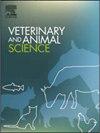Characterization of the internal quality of turkey eggs according to their commercial grading
IF 1.9
Q2 AGRICULTURE, DAIRY & ANIMAL SCIENCE
引用次数: 0
Abstract
The present study aimed to determine the influence of egg weight and shape index on the internal quality of turkey eggs. To this aim, a total of 197 turkey eggs were measured including external and internal egg quality traits. Different egg categories were built attending to the weight terciles of the sample and the commercial shape index standards. A Discriminant Canonical Analysis (DCA) was performed using these categories as dependent variables, while the internal quality attributes acted as explanatory variables. The yolk percentage was the only variable reporting multicollinearity and was therefore removed from further analysis. The Pillai’s trace criterion was significative (p < 0.05) and validated the performance of the DCA. Moreover, the cross-validation test reported a high accuracy of correct assignments (95.88 %), which validated the applicability of the statistic model. The diameter and lightness of the yolk, the proportion of shell in the overall weight, and the height and pH of the albumen were the variables reporting discriminatory ability across weight and shape index groups. Similar associations between the internal quality and egg weight were found in the literature, while the connections with the shape index were less frequent. The present work eases the efficient determination of increased-quality eggs from their external appearance. However, quality perception varies with the consumer preferences of each market. Therefore, heavier eggs will offer larger yolks and reduced shell percentage in weight, while lighter and rounder eggs will tend to present darker yolks, with taller albumen and lower gas exchange during storage.
根据商业等级对火鸡肉蛋的内在品质进行表征
本研究旨在确定蛋重和形状指数对火鸡肉蛋内在品质的影响。为此,共测定了197个火鸡蛋的外部和内部品质性状。根据样品的重量等级和商业形状指标标准,建立了不同的鸡蛋类别。使用这些类别作为因变量进行判别典型分析(DCA),而内部质量属性作为解释变量。蛋黄百分比是唯一报告多重共线性的变量,因此从进一步的分析中删除。皮莱痕量标准具有显著性(p <;0.05),验证了DCA的性能。此外,交叉验证检验报告了较高的正确率分配(95.88%),验证了统计模型的适用性。蛋黄的直径和轻度、蛋壳占总重的比例、蛋白的高度和pH值是报告重量和形状指数组之间区分能力的变量。在文献中也发现了类似的内在质量和蛋重之间的联系,而与形状指数的联系则不那么频繁。本工作从外观上简化了对优质鸡蛋的有效测定。然而,质量感知因每个市场的消费者偏好而异。因此,较重的鸡蛋蛋黄较大,蛋壳重量百分比较低,而较轻、较圆的鸡蛋蛋黄颜色较深,蛋白较高,储存过程中气体交换较低。
本文章由计算机程序翻译,如有差异,请以英文原文为准。
求助全文
约1分钟内获得全文
求助全文
来源期刊

Veterinary and Animal Science
Veterinary-Veterinary (all)
CiteScore
3.50
自引率
0.00%
发文量
43
审稿时长
47 days
 求助内容:
求助内容: 应助结果提醒方式:
应助结果提醒方式:


